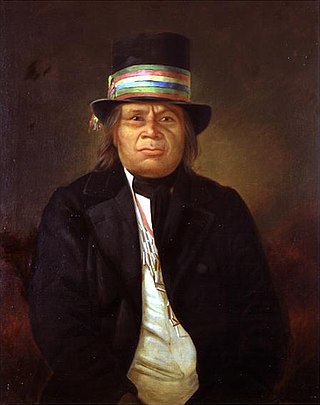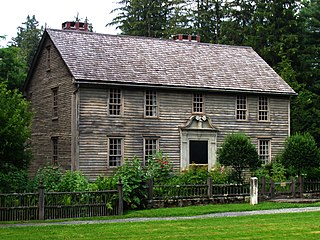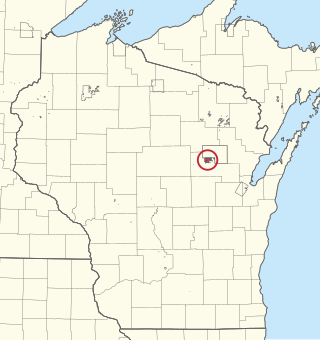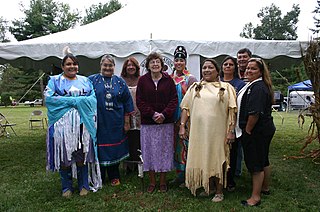
The Mohicans are an Eastern Algonquian Native American tribe that historically spoke an Algonquian language. As part of the Eastern Algonquian family of tribes, they are related to the neighboring Lenape, whose indigenous territory was to the south as far as the Atlantic coast. The Mohican lived in the upper tidal Hudson River Valley, including the confluence of the Mohawk River and into western New England centered on the upper Housatonic River watershed. After 1680, due to conflicts with the powerful Mohawk to the west during the Beaver Wars, many were driven southeastward across the present-day Massachusetts western border and the Taconic Mountains to Berkshire County around Stockbridge, Massachusetts.

Germantown is a town in Columbia County, New York, United States. The population was 1,936 at the 2020 census, down slightly from 1,954 in 2010. Germantown is located in the south-western part of the county along the east side of the Hudson River.

Red Hook is a town in Dutchess County, New York, United States. The population was 9,953 at the time of the 2020 census, down from 11,319 in 2010. The name is most likely taken from Red Hook Brooklyn, the New York City neighborhood which shares a similar red (soil) outcropping on its waterfront or "rood hoek" in Dutch. The town contains two villages, Red Hook and Tivoli. The town is in the northwest part of Dutchess County.

The Menominee are a federally recognized tribe of Native Americans officially known as the Menominee Indian Tribe of Wisconsin. Their land base is the Menominee Indian Reservation in Wisconsin. Their historic territory originally included an estimated 10 million acres (40,000 km2) in present-day Wisconsin and the Upper Peninsula of Michigan. The tribe currently has about 8,700 members.
Bill Miller is a Native American singer/songwriter and artist of Mohican heritage. He is a guitarist, player of the Native American flute and painter.

The Mission House is an historic house located at 19 Main Street, Stockbridge, Massachusetts. It was built between 1741 and 1742 by a Christian missionary to the local Mahicans. It is a National Historic Landmark, designated in 1968 as a rare surviving example of a colonial mission house. It is now owned and operated as a nonprofit museum by the Trustees of Reservations.

The Wappinger were an Eastern Algonquian Munsee-speaking Native American people from what is now southern New York and western Connecticut.

The Stockbridge–Munsee Community, also known as the Mohican Nation Stockbridge–Munsee Band, is a federally recognized Native American tribe formed in the late eighteenth century from communities of so-called "praying Indians", descended from Christianized members of two distinct groups: Mohican and Wappinger from the praying town of Stockbridge, Massachusetts, and Munsee (Lenape), from the area where present-day New York, Pennsylvania and New Jersey meet. Their land-base, the Stockbridge–Munsee Indian Reservation, consists of a checkerboard of 24.03 square miles (62.2 km2) in the towns of Bartelme and Red Springs in Shawano County, Wisconsin. Among their enterprises is the North Star Mohican Resort and Casino.
Brent Michael Davids is an American composer and flautist.
The Mohegan are an Algonquian Native American tribe historically based in present-day Connecticut. Today the majority of the people are associated with the Mohegan Indian Tribe, a federally recognized tribe living on a reservation in the eastern upper Thames River valley of south-central Connecticut. It is one of two federally recognized tribes in the state, the other being the Mashantucket Pequot, whose reservation is in Ledyard, Connecticut. There are also three state-recognized tribes: the Schaghticoke, Paugusett, and Eastern Pequot.

Daniel Nimham (1726–1778) was the last sachem of the Wappinger people and an American Revolutionary War combat veteran. He was the most prominent Native American of his time in the lower Hudson Valley.

Chief Oshkosh was a chief of the Menominee Native Americans, recognized as the leader of the Menominee people by the United States government from August 7, 1827, until his death. He was involved in treaty negotiations as the United States sought to acquire more of the Menominee tribe's land in Wisconsin and Michigan for both white settlers and relocated Oneida, Stockbridge, Munsee, and Brothertown Indians. During his tenure as head chief, the Menominee ceded over 10,000,000 acres of land to the United States. However, Oshkosh resisted U.S. government pressure for the tribe to relocate to northern Minnesota and played a key role in securing the 235,524-acre (953.13 km2) Menominee Indian Reservation as a permanent home for his people on their ancestral land.
Mohican is a language of the Eastern Algonquian subgroup of the Algonquian language family, itself a member of the Algic language family. It was spoken in the territory of present-day eastern New York state and Vermont by the Mohican people but is believed to have been extinct since the 1930s. However, since the late 2010s, the language is being revived, with adults learning the language, and children being raised having Mohican as their first language.
Menominee Tribe v. United States, 391 U.S. 404 (1968), is a case in which the Supreme Court ruled that the Menominee Indian Tribe kept their historical hunting and fishing rights even after the federal government ceased to recognize the tribe. It was a landmark decision in Native American case law.

The Munsee are a subtribe and one of the three divisions of the Lenape. Historically, they lived along the upper portion of the Delaware River, the Minisink, and the adjacent country in New York, New Jersey, and Pennsylvania. They were prominent in the early history of New York and New Jersey, being among the first Indigenous peoples of that region to encounter European colonizers.
Noah Watts is a Native American actor and musician, a member of the Crow Tribe, and a descendant of the Blackfeet Nation. He bears the Crow name Bulaagawish, which means "Old Bull".

Electa Quinney was a Mohican and member of the Stockbridge-Munsee Community. She founded one of the first schools in what would become Wisconsin and was the first woman to teach in a public school in the territory which would be Wisconsin.
Grand Avenue is a 1996 American drama film directed by Daniel Sackheim and written by Greg Sarris. It is based on the 1994 novel Grand Avenue by Greg Sarris. The film stars Irene Bedard, Tantoo Cardinal, Eloy Casados, Deena-Marie Consiglio, Alexis Cruz, Diane Debassige, Jenny Gago, Cody Lightning, A Martinez, Simi Mehta, August Schellenberg, Sheila Tousey and Sam Vlahos. The film premiered on HBO on June 30, 1996. The film is one of the only American films to feature an indigenous Native American lead role for an actress, played by Menominee actress Tousey.

Dorothy Davids was an American educator, educational services administrator, and a Native American and women's rights activist. She was an enrolled member of the Stockbridge–Munsee Community. Born in Red Springs, Wisconsin, she attended school in the Native American boarding school system. These schools did not allow students to speak their Native languages or practice their cultural traditions and focused on assimilating Indigenous people into mainstream society.










